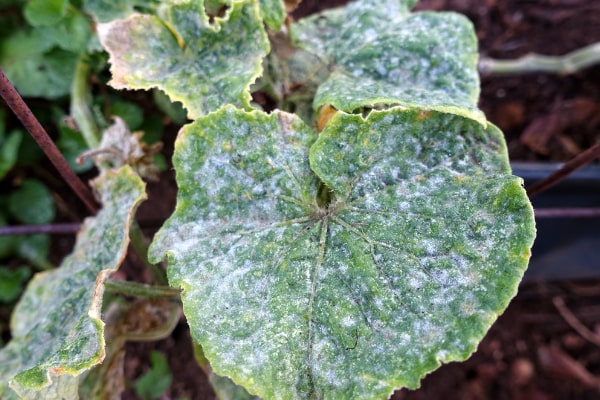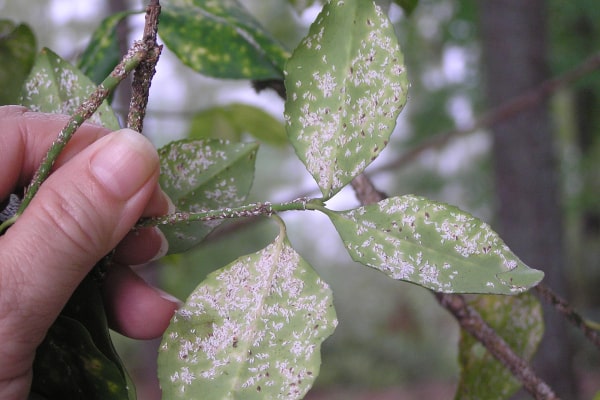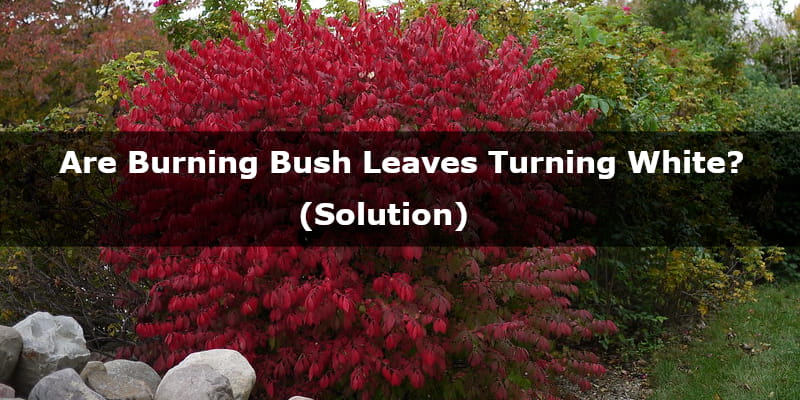So, You’ve noticed white leaves on your Burning Bush?
Don’t fret, in this article you’ll learn what’s the reason behind it, and how you can fix it!
Why are Burning Bush Leaves Turning White?
Burning Bush leaves are turning white, because of the following reasons:
- Powdery Mildew (the most common reason)
- Sunscald
- Scale
- Exposure to chemicals
- Deficiency of nutrients
However, the most popular reasons are powdery mildew or scale, and they are typical for euonymus. Keep reading, to find out what to do about it.
1. Powdery Mildew
The most common reason why your Burning Bush leaves are turning white is powdery mildew fungi. Powdery mildew thrives in spring, and fall, when there’s high humidity at night, low humidity during the day, and temperatures of 70-80 °F (21-26° C).
Powdery mildew looks like dusty splotches of white or gray powder, usually on the young leaves and stems of infected plants. However, the disease typically starts on the undersides of leaves, often appearing on the stems, and flower buds.
On the picture below, you can see how powdery mildew looks like.

This disease will not kill your euonymus alatus, but will worsen its appearance, and make it more prone to other diseases and insect damage. Also, it can leech nutrients from the leaves, making them yellow, and weaker.
If you’ve just noticed powdery mildew on a few leaves, the first step you need to take is to cut back the infected leaves. That way you prevent fungi to spread. Remember to use gloves. Don’t compost leaves, because it can make the spores of powdery mildew spread. If there are hundreds of leaves infected, it’s not worth removing them, because other, healthy-looking leaves are already infected.
Another step to take is applying a fungicide. The right fungicide should contain potassium, bicarbonate, sulfur, neem oil, or copper. The most effective one is this one on Amazon. It will not kill fungi, but can help stem the spread of the fungi to other leaves or plants. Applying the fungicide every 7-14 days gives great results.
If your Burning Bush is small, it might not have enough space to breathe properly, because other plants disturb air circulation. Always make sure that your plants have good air circulation to prevent powdery mildew.
Also, you should avoid watering your shrub from above, because excessive water promotes more mildew growth. To stop fungi from developing, you can also think about moving your plants to the sunnier area, because powdery mildew thrives in shade.
2. Sunscald
Some shrubs, growing in high heat, experience leaf scald as active cells become overworked by extreme heat conditions. Sunscald damage in leaves occurs on the top part of the plant, and the parts most exposed to the elements. To recognize sunscald, take a look at the leaves. Often the top leaves of Burning Bush turn white, while lower growth remains unscathed in the shade of dead leaves.
Plants with sunscald damage are more susceptible to attacks by pests, and they’re more likely to contract diseases.
Suscald might occur when Burning Bush is exposed to the direct sun all day long, and the temperatures exceed 85 °F (30 °C) for at least a couple of days. It’s a normal response of the plant to heat, as euonymus alatus grows best at about 70 °F (20 °C).
3. Scale
White leaves might also mean the unaspis euonymi presence. To recognize this scale, you should inspect the undersides of leaves. Euonymus scale females grow up to 1/16 inch (1,5 mm) in length, are brown, and are shaped like tiny oyster shells. Euonymus scale males are smaller than females, white, and elongated.
Euonymus scales feed on plant sap. Feeding damage first appears as yellow, or whitish spots on leaves. When infestations are heavy, scales encrust leaves and branches, with feeding damage causing defoliation and branch dieback.
On the picture below, you can see how scale looks like on the leaves of other euonymus species.

 Euonymus scale can be difficult to control. Heavily infested branches should be removed. Spray insecticides containing carbaryl, cyfluthrin, horticultural oil, insecticidal soap, malathion, or permethrin can be used for control of the crawler stage of Euonymus scale. You can buy this one on Amazon.
Therefore, spray treatments should be started in early June, and three applications made at 10 to 12-day intervals are needed to achieve control.
Other Reasons Behind White Leaves on Burning Bush Leaves
Here are less popular, but still probable, reasons why your Burning Bush leaves are turning white.
Exposure to Chemicals
You, or your neighbors, might use chemicals, or gases like sulfur dioxide. Different plants react differently to the chemicals. Because of that, your Burning Bush leaves might turn pale, or white.
Deficiency of Nutrients
Sometimes, leaves may go pale, because they lack nutrients. The most important one is nitrogen that promotes healthy leaf production. You might want to apply fertilizer, that’s rich in nitrogen, for example a 20-0-0 fertilizer.
Related: How Fast Do Euonymus Grow? (Important Facts)
How to Prevent White Leaves on Burning Bush Leaves in the Future?
There are things you can do to prevent either powder mildew, or scale in the future.
- Treat the shrub with neem oil: Even if the powder mildew, or scale are invisible, you can do something to prevent it. Once a week, spray your Burining Bush tree with neem oil (buy it here on Amazon) that kills fungi, and not let it spread. In the effect, your tree will be fungi-tree during the whole year.
- Amend the soil: To promote healthy bushes, and trees, you need to provide the right conditions, and they will be less likely to get a disease. Consider amending your garden soil with organic fertilizers and well-aged compost, and water with homemade compost tea and aloe vera extract. Develop a consistent watering schedule and avoid drought stress too.
- Cut off some plants: Some plants are more likely to get powder mildew, or scale, than another. Because of that, they might infect your Burning Bush too. So, to avoid it, you should cut off plants, like zucchini, melon, cucumber, tomatoes, peppers, or beans. However, if you still want to keep them in your yard, make sure they grow far away for the Burning Bush.
- Don’t water leaves: When you water your Burning Bush, don’t water the leaves, even if they are wilting. It is the factor that promotes fungi. Water only the soil.
Sources
thespruce.com, epicgardening.com, hort.extension.wisc.edu, evergreenseeds.com, homesteadandchill.com

